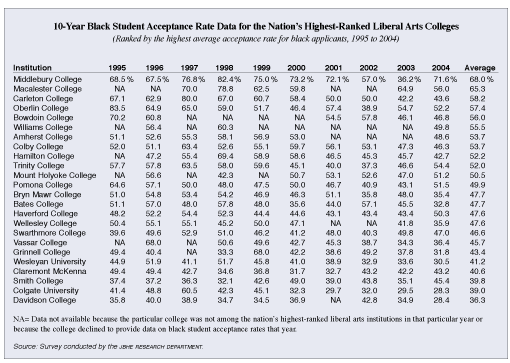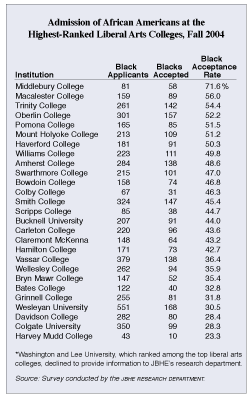| The High-Ranking Liberal Arts Colleges Where Black Students Stand the Best Chance of Admission Long-term statistics show that at the vast majority of the nation's 25 highest-ranking liberal arts colleges, no less one third of all black applicants are accepted for admission. These acceptance rates have held true in each of the past 10 years. Also, more than one half of all black applicants have been admitted at 11 of these high-ranking colleges. Over the past decade at Middlebury College in Vermont, an average of 68 percent of all black applicants have been admitted.
When JBHE published its first issue in 1993, one of its stated missions was to provide college-bound African-American students with information that would better equip them to make informed decisions on their best chances for success in higher education. To this end we have amassed a huge database of information on the standing and prospects of blacks in higher education. Brand names in higher education continue to rule the day. American society places great importance on the credential obtained by graduating from one of the nation's highest-ranked colleges or universities. For blacks, a diploma from Harvard, Stanford, or Williams College provides a solid boost in efforts to gain admission to graduate or professional school or to secure a good job at one of the nation's most successful corporations. Blacks with a diploma from one of the nation's most selective and prestigious colleges or universities tend to be well on their way to success in life. Acceptance Rates for Black Students For the past decade, JBHE has been collecting data on the acceptance rates of black applicants at the nation's highest-ranked universities and liberal arts colleges. A small number of the nation's top-ranked universities have been unwilling to divulge information on their black student acceptance rates. But our data on black student acceptance rates at the nation's leading liberal arts colleges is considerably stronger than is the case for the large research universities.
In the fall of 2004 all 27 high-ranking liberal arts colleges in our survey provided detailed information on their acceptance rates for black students. For the current academic year the black acceptance rate was greater than 50 percent at seven of the 27 highest-ranked liberal arts colleges. Mid-dlebury College had the highest black applicant acceptance rate of these 27 institutions. At this highly selective college in Vermont, 58, or 71.6 percent, of the 81 black applicants were accepted for admission. The other six highly ranked liberal arts colleges that accepted more than one half of their black applicants in 2004 were Macalester College, Trinity College, Oberlin College, Pomona College, Mount Holyoke College, and Haverford College. At the lower end of the acceptance rate rankings, only 10, or 23.3 percent, of the 43 black applicants to Harvey Mudd College in California were accepted for admission. Bates College, Grinnell College, Wesleyan University, Davidson College, and Colgate University all accepted less than one third of the black students who applied in 2004. Black Acceptance Rates
While the 2004 data on black acceptance rates gives college-bound blacks students a good clue on their chances of admission to the nation's high-ranking liberal arts colleges, long-term information in the JBHE database on acceptance rates over the past decade yields a more comprehensive view. This is so because single-year data often contains a statistical blip that is not indicative of overall opportunity. A particular college could have a very strong black applicant pool one year resulting in a very high acceptance rate. Similarly, a college might have an off year in attracting outstanding young black applicants, which would result in a low acceptance rate for blacks that year. The accompanying table shows the 10-year average of the black acceptance rate at the nation's highest-ranked liberal arts colleges. Middlebury once again sits at the top. The average black applicant acceptance rate at Middlebury over the past 10 years is 68 percent. Thus, on average, over two thirds of all black applicants to Middlebury over the past 10 years have been accepted for admission. Probably one reason for the high black student acceptance rate at Middlebury is the fact that the college has consistently had to cope with a low black student yield. Therefore, it appears to accept a large number of black applicants in order to maintain some level of racial diversity on its remote Vermont campus. JBHE research also shows that nearly two thirds of all black applicants to Macalester College in Minnesota are accepted. At Carleton College, also in chilly Minnesota, an average of 58 percent of black applicants have been approved for admission over the past decade. But note that there have been wide fluctuations in the black acceptance rate. In 1997, 80 percent of all blacks were admitted. For the past two years the black acceptance rate has averaged 42.9 percent, considerably lower than the 10-year average. At Williams College and Amherst College, two of the most selective liberal arts colleges in the nation, more than 50 percent of all black applicants have been accepted over the past decade. The acceptance rate at these top-ranking colleges for applicants of all races stands at about 20 percent. A note of caution: It is important to remember that the black acceptance rate at all of the high-ranking liberal arts colleges averages at least 36 percent over the past decade. Even the colleges with relatively low acceptance rates are still accepting many dozens of black students each year. College-bound black students with top-notch academic qualifications should not be discouraged from applying to any of these schools. Moreover, the vast majority, if not all, of the high-ranking liberal arts colleges actively recruit black students. They all seek greater racial diversity in their student bodies. While it appears that a black applicant is twice as likely to be admitted to Middlebury College than to Davidson College, a black applicant to Davidson with a strong academic resume is also likely to meet with success. | |





